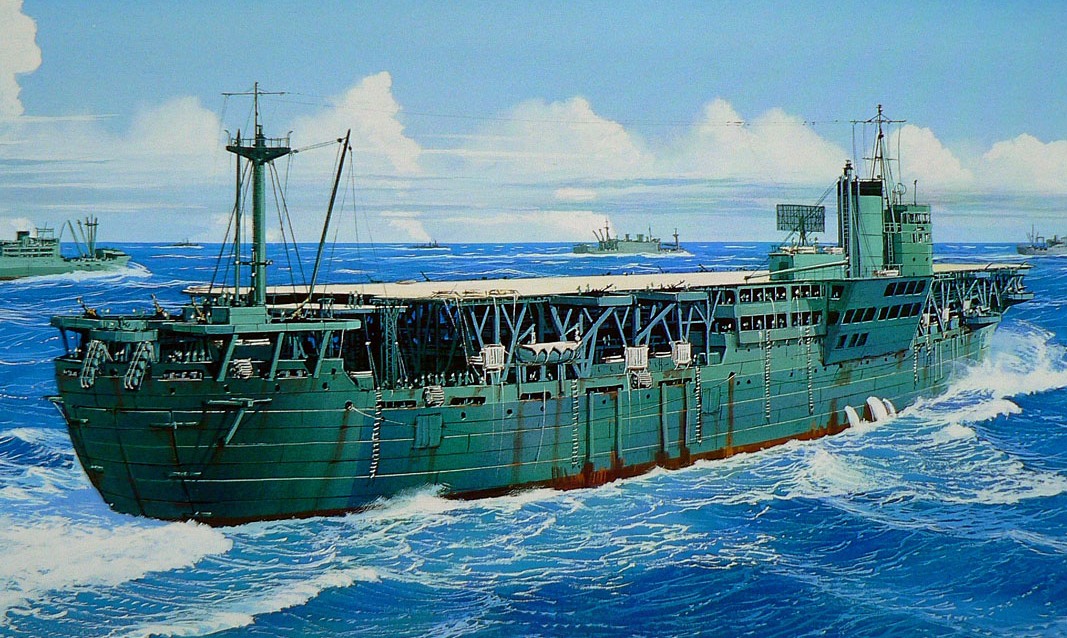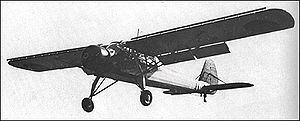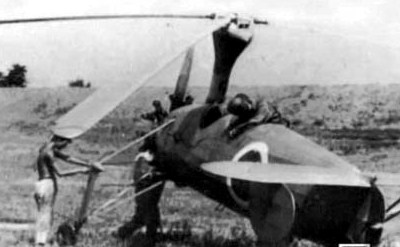TETSUSEI DAI HATSUDOTEI
 (AKITSU MARU by Ueda Kihachiro)
(AKITSU MARU by Ueda Kihachiro)
IJA Landing Craft Depot Ship AKITSU MARU:
Tabular Record of Movement
© 2011-2018 Bob Hackett and Peter Cundall
Revision 7
17 September 1939:
Aioi. Laid down at Harima Shipbuilding as a passenger liner for Nippon Kaiun, K. K.
June 1941:
Requisitioned by the IJA and ordered converted on the stocks to a 9,186-ton assault landing ship with IJA No. 999. The ship is fitted with a flight deck above the hull, but has no hangar.
24 September 1941:
Launched and named AKITSU MARU.
30 January 1942:
Completed.
6 February 1942:
Departs Aioi.
9 February 1942:
Arrives at Takao.
10 February 1942:
Departs Takao.
15 February 1942:
Arrives at Camrahn Bay, Indochina.
18 February 1942: Operation "J" - The Invasion of Java, Netherlands East Indies:
AKITSU MARU is attached to Vice Admiral Takahashi Ibo's (36) Third Fleet, Southern Force, Netherlands East Indies Force in Vice Admiral Ozawa Jisaburo’s (37) Western Java Seizure Force. Departs Camranh Bay in a convoy comprised of 56 troop transports. They carry the 2nd Infantry Division for the invasions of
Merak and Bantam Bay, Java escorted by light cruisers YURA and NATORI, DesDivs 5, 6, 11, 12 and 22.
Fifteen transports go to Merak, Java including AKITSU, KOYO, HOKUMEI (later NIKKEI), COLUMBIA, ATLAS, RYUNAN, MOMOYAMA, PACIFIC, KIZAN, REIYO, TSUYAMA, SYDNEY and SHINSHU MARUs. Seven transports go to Eretan Wetan. Seaplane tender SANYO MARU provides air cover. Departs Camrahn Bay.
1 March 1942:
Arrives at Merak, Java. Lands troops of the IJA’s 2nd Infantry Division.
9 March 1942:
Arrives at Bantam Bay.
13 March 1942:
Departs Bantam Bay.
16 March 1942:
Arrives at Singapore.
17 March 1942:
Departs Singapore.
20 March 1942:
Arrives at Takao.
22 March 1942:
Departs Takao.
25 March 1942:
Arrives at Kirun (Keelung).
28 March 1942:
Departs Kirun.
2 April 1942:
Arrives at Dairen, Manchuria.
9 April 1942:
Departs Dairen.
11 April 1942:
Arrives at Ujina.
26 May 1942:
Departs Moji.
29 May 1942:
Arrives at Saigon.
7 June 1942:
At 0330 departs Moji.
12 June 1942:
At 0900 arrives at Saigon. Later that day departs Saigon.
15 June 1942:
Arrives at Singapore.
24 July 1942:
Departs Singapore.
27 July 1942:
Arrives at Takao.
28 July 1942:
Departs Takao.
2 August 1942:
Arrives at Moji and later that day at Ujina.
4 September 1942:
Departs Ujina.
15 September 1942:
Arrives at Singapore.
17 September 1942:
Departs Singapore.
21 September 1942:
Arrives at Saigon and departs that day for Wake Island.
30 September 1942:
Arrives Wake Is.
3 October 1942:
Departs Otori Jima (Wake Island) escorted by destroyer YUZUKI.
7 October 1942:
Arrives at Truk.
10 October 1942:
Departs Truk for Saipan escorted by destroyer YUZUKI.
11 October 1942:
YUZUKI is detached.
16 October 1942:
Arrives at Ujina.
25 October 1942:
Departs Ujina.
26 October 1942:
Arrives at Saeki and departs later that day escorted by patrol boat PB-31 and torpedo boat HATO.
E 27 October 1942:
The escorts are detached.
3 November 1942:
Arrives at Rabaul.
5 November 1942:
Photographed at high level by an Allied reconnaissance aircraft lying in Simpson Harbour with steam up and bow towards the harbour entrance.
9 November 1942:
Departs Rabaul.
16 November 1942:
Arrives at Ujina. Joined by torpedo boat HATO at 31-55N, 132-15E that escorts her north to Himejima.
23 November 1942:
Departs Kure for Truk escorted by destroyers ARASHI and NOWAKI, probably ferrying aircraft. For a brief while patrol boat PB-31 joins the escort in the Bungo Suido area.
E 27 November 1942:
Arrives at Truk.
E 28 November 1942:
Departs Truk for Rabaul escorted by destroyers ARASHI and NOWAKI, probably ferrying aircraft.
1 December 1942:
Arrives at Rabaul.
7 December 1942:
Departs Rabaul.
16 December 1942:
Arrives at Ujina.
27 December 1942:
Departs Ujina. Joined by torpedo boat HATO off Saeki that escorts her south.
E 28 December 1942:
HATO is detached at 29N.
1 January 1943:
Arrives at Truk.
2 January 1943:
At 0600, arrives at Truk.
4 January 1943:
At 1400, departs Truk escorted by destroyer OKIKAZE.
6 January 1943:
Torpedo boat HIYODORI takes over as escort at 00-20S, 147-50E.
7 January 1943:
Arrives at Rabaul.
9 January 1943:
Departs Rabaul.
16 January 1943:
Joined by minelayer NASAMI at 29-28N that escorts her north.
17 January 1943:
NASAMI is detached off Fukajima. Arrives at Ujina.
30 January 1943:
Departs Ujina, probably carrying munitions.
2 February 1943:
At 0700 departs Moji at 16 knots escorted by minesweeper W-1. The ships stop at Sakito Suido. At an unknown point W-1 is detached and returns to Kyushu.
10 February 1943:
Arrives at Surabaya, probably unloads munitions.
15 February 1943:
Departs Surabaya. At 1400, her position is NW of Aru Bank where she is to rendezvous with an escort that will stay with her to longitude 126 degrees East.
25 February 1943:
Arrives at Truk escorted by destroyer TANIKAZE.
26 February 1943:
Departs Truk escorted by destroyer OITE. At 10-48ZN 146-18E OITE detaches and returns to Truk.
2 March 1943:
Joined by torpedo boat HATO at 28-30N, 134-38E that escorts her north.
3 March 1943:
HATO is detached off Fukajima. Arrives at Ujina.
4 March 1943:
Departs Iwakuni, probably carrying aircraft.
17 March 1943:
From about 1200 submarine chaser KAII escorts AKITSU MARU that is en route to Singapore, between Tomie and Kusagaki Jima.
E 23 March 1943:
Arrives at Singapore.
30 March 1943:
Departs Singapore.
6 April 1943:
Joined by patrol boat PB-31 at 27-17N, 130-42E that escorts her north.
7 April 1943:
PB-31 is detached off Fukajima. Arrives at Ujina.
17 April 1943:
Departs Iwakuni, probably carrying aircraft.
19 April 1943:
Departs Saeki with patrol boat PB-31 that escorts her south.
E 20 April 1943:
PB-31 is detached at 29N.
29 April 1943:
Arrives at Seletar Naval Base, Singapore. Probably undergoes minor maintenance or repairs at the No. 101 Repair Facility.
2 May 1943:
Departs Seletar.
7 May 1943:
Arrives at Singapore.
8 May 1943:
Departs Singapore.
13 May 1943:
Arrives at Ujina.
7 June 1943:
Departs Ujina.
11 June 1943:
Joined off Saei by torpedo boat HATO and minelayer YURIJIMA that escort her south.
E 12 June 1943:
The escorts are detached at 29N.
22 June 1943:
Arrives at Rabaul.
26 June 1943:
Departs Rabaul.
3 July 1943:
At 0700, departs Palau unescorted making 18 knots.
7 July 1943:
Joined by minelayer YURIJIMA at 29-57N, 134-01E and heads north.
8 July 1943:
YURIJIMA is detached off Fukajima.
9 July 1943:
Arrives at Ujina.
25 July 1943:
Departs Ujina.
26 July 1943:
Departs Iwakuni ferrying 30 aircraft and 20 landing barges.
31 July 1943:
At 0800 departs Moji in O convoy also consisting of MIIKE and ORYOKU MARUs and two unidentified merchant ships escorted by destroyer KARUKAYA.
4 August 1943:
Arrives at Takao. ORYOKU MARU has already detached for Kirun.
5 August 1943:
Departs Takao in convoy No. 764 with MIIKE MARU escorted by destroyer SHIOKAZE.
7 August 1943:
Arrives at Manila.
15 August 1943:
Departs Manila.
24 August 1943:
Arrives at Ujina.
10 September 1943:
At 1600, departs Moji in convoy HI-09 also consisting of tankers NICHINAN (5175 gt) and TATEKAWA MARUs, cargo-passenger ship MIIKE MARU, and two unidentified ships likely tankers MIRI and OTOWASAN MARUs escorted by the kaibokan MATSUWA.
13 September 1943:
Separates from HI-09. At 1000 departs Mako escorted by destroyer SANAE.
16 September 1943:
At 0830 arrives at Manila.
22 September 1943:
At 0630 departs Manila as sole ship in Rinji convoy escorted by destroyer KARUKAYA.
23 September 1943:
At 1616 arives at Takao.
26 September 1943:
Departs Iwakuni, probably ferrying aircraft.
4 October 1943:
Departs Takao.
9 October 1943:
Arrives at Moji.
28 October 1943:
AKITSU MARU departs Ujina and arrives at Moji. At 1607, departs Moji in convoy HI-17 also consisting of passenger ship ASAMA MARU, transport SAKITO MARU and tankers OMUROSAN, TATEKAWA and ITSUKUSHIMA MARUs escorted by kaibokan ETOROFU and MATSUWA.
30 October 1943:
At 0430 SAKITO MARU at 31.55N 123.10E collides with passenger ship SHANGHAI MARU part of MO-902 convoy bound from Shanghai to Kyushu. SHANGHAI MARU is hit low in the bow and flooding can't be checked. At 0516 the ship sinks. The convoy including SAKITO MARU continues its voyage south.
1 November 1943:
At 1115, arrives at Takao. Passenger ship KACHIDOKI MARUs (ex-SS PRESIDENT HARRISON), tankers TAKASAKI and OTORISAN, OTOWASAN and TARAKAN MARUs join the convoy.
4 November 1943:
At 0400, destroyer FUYO departs Manila to meet convoy HI-17 incoming from Takao. At 1900, the convoy arrives at Manila. AKITSU MARU is detached.
6 November 1943:
Departs Manila for Takao.
12 November 1943:
AKITSU MARU and five unidentified ships depart Takao for Manila escorted by torpedo boat TOMOZURU.
18 November 1943:
At 1400 AKITSU MARU departs Manila escorted by torpedo boat TOMOZURU. Off Manila Bay. Cdr (later Captain) Henry G. Munson’s (USNA ’32) USS CREVALLE (SS-291) fires six unreliable Mark 14-3A torpedoes at AKITSU MARU. Munson later claims sinking an 18,000-ton aircraft ferry; but AKITSU MARU is not damaged by the dud torpedoes.
At 2300, USN codebreakers intercept and decrypt a message from TOMOZURU that reads: “At 2115 in position 15-10 N., 119-40 E. Akitsu Maru received torpedo attack. (3 torpedoes). No damage ------.”
19 November 1943:
At 1830 arrives at Lingayen.
20 November 1943:
Kaibokan MATSUWA rendezvous with AKITSU MARU at 21-22N, 120-00E and escorts her to Takao.
26 November 1943:
AKITSU MARU departs Takao in convoy No. 222 consisting of HAKONE, HAWAII, NITTATSU, SHUNKO, HOTEN and ROKKO MARUs and tankers SEINAN MARU and OGURA MARU No. 2 escorted by torpedo boat TOMAZURU.
27 November 1943:
SE of Foochow, China. Three B-25 “Mitchell' medium bombers attack the convoy and sink HAKONE MARU carrying 9,500-tons of important raw materials. No casualties are sustained.
28 November 1943:
The convoy less TOMOZURU and NITTATSU MARU that stayed to assist HAKONE MARU and HAWAII MARU that detaches, sails up the China coast without escort. At 1854 Naval tug KASASHIMA departs Taichow Liehtao and meets up with the convoy.
29 November 1943:
At 0713 off Chiu Shan Liehtao the escort by KASASHIMA ends.
30 November 1943:
At 0550 the convoy fully reassembles off the mouth of the Yangtse and then heads to Moji.
3 December 1943:
Arrives at Moji.
29 December 1943:
Departs Ujina carrying the 6th South Seas Detachment (two infantry battalions and a tank company) and other unidentified units.
19 January 1944:
Arrives at Palau.
26 February 1944:
Departs Ujina.
9 March 1944:
Reported in the Takao area.
19 March 1944:
Arrives at Manila.
27 March 1944:
Departs Manila.
9 April 1944:
Arrives at Ujina.
13 April 1944:
Aioi. Undergoes remodelling construction at Harima shipyard. The bridge and funnel are moved to starboard to allow installation of a flight deck for flying off the ship’s her seven Army Ki-76 aircraft. A single lift is at the aft end of this deck. [1]
30 July 1944:
Remodelling is completed.
6 August 1944:
Departs Ujina. Her aircraft probably conduct airborne anti-submarine patrols.
8 August 1944:
Arrives at Fusan (Pusan), Korea.
9 August 1944:
Departs Fusan. Her aircraft probably conduct airborne anti-submarine patrols.
11 August 1944:
Arrives at Moji.
12 August 1944:
Departs Moji.
14 August 1944:
Arrives at Otaru.
19 August 1944:
Departs Otaru.
21 August 1944:
Arrives at Mutsure.
30 September 1944:
Departs Moji. Her aircraft probably conduct airborne anti-submarine patrols.
6 November 1944:
Arrives at Fusan.
9 November 1944:
Departs Fusan. AKITSU MARU's aircraft probably conduct airborne anti-submarine patrols. Later that day arrives at Moji.
13 November 1944:
Departs Moji and arrives at nearby Imari Bay.
14 November 1944:
Departs Imari Bay for Singapore in convoy HI-81 also consisting of SHINSHU, KIBITSU, ARITA, OTOWASAN, HASHIDATE, KIYOKAWA, MAYASAN, MIRII and TOA MARUs escorted by destroyer KASHI and kaibokan ETOROFU (F), TSUSHIMA, DAITO, KUME, SHONAN, CD-9 and CD-61. The convoy carries about 4,500 men of the IJA’s 23rd Infantry Division being deployed to the Philippines.
AKITSU MARU is loaded with the 23rd Division’s artillery and men of Hq, 64th Infantry Regiment, 1st and 2nd Battalions, 64th Inf, 1st Company, 2nd Battalion 72nd Infantry Regiment, 1st Company, 23rd Engineers and about 500 horses. AKITSU MARU carries also non-divisional units and the IJA’s 20th Sea
Raiding Battalion with 104 “Maru-ni” explosive motor boats (EMB). Her flight and hangar decks are fully loaded with aircraft also intended for the Philippines. Stops overnight at Goto Island.
AKITSU MARU also carries two Kayaba Ka-1 autogyros for anti-submarine use. The Ka-1’s each carry one small 60 kg (132 lb) depth charge. [2]
15 November 1944:
Departs Goto Island. Escort carrier SHINYO takes up position at the rear of the center of three columns of vessels.
Korean Strait. LtCdr (later Rear Admiral-Ret) Charles E. Loughlin's (USNA ’33) USS QUEENFISH (SS-393) receives an “Ultra” signal from USN codebreakers that indicates the point in the East China Sea where the land-based escort is to rendezvous with the convoy.
At 1052, USS QUEENFISH sights the convoy through her periscope. The air cover consists of many twin-engined Mitsubishi G3M "Nell" medium bombers and single float planes, probably Mitsubishi F1M “Petes”. USS QUEENFISH is spotted by an aircraft just before firing torpedoes. The plane drops a smoke float that guides the escorts to the submarine’s position.
At 1155, USS QUEENFISH fires four stern torpedoes and gets two hits that sink AKITSU MARU at 33-17N, 128-11E. One of the torpedoes sets off AKITSU MARU’s aft magazine holding depth charges to be carried by the “Maru-ni” EMB suicide boats aboard. Induced explosions shatter the aft portion of the ship. As the seas hit her boilers, they explode. In three minutes, she capsizes to port and takes down
67 crewmen, 140 gunners and 2,093 men of the IJA's 64th Infantry Regiment, including the commander, and other units aboard. Over the next twenty-four hours, the escorts rescue 310 survivors.
SHINYO's planes attempt to locate and destroy the submarine, but fail to find her. Landing craft depot ship SHINSHU MARU drops depth charges during and after the sinking of AKITSU MARU.
16 November 1944:
Off Korea. The convoy anchors near Strange Island and shelters there.
17 November 1944:
At 0800, convoy HI-81 departs for the Shushan Islands near Shanghai. At 1815, LtCdr (later Cdr) Evan T. Shepard's (USNA ’35) USS PICUDA (SS-382) torpedoes and sinks MAYASAN MARU with the loss of 56 crewmen, 194 gunners and 3,187 troops of the 4,500 men and 204 horses of IJA’s 23rd Division she was carrying. All “Maru-ni” explosive motor boats (EMB) of the IJA's 24th Sea Raiding Battalion are also lost. The escorts rescue about 1,300 men.
At 2002, kaibokan ETOROFU asks for rescue of MAYASAN MARU at 33-17N 124-45E.
At 2040, kaibokan SHONAN claims sinking a sub at 33-10'N 124-40E after detecting the sub 3 miles west of the 1815 MAYASAN MARU disaster at 33-17N, 124-45E. SHONAN reports searching with DAITO. 30 depth charges are expended.
At 2309, LtCdr (later Captain) Gordon W. Underwood’s (USNA ’32) USS SPADEFISH (SS-411) torpedoes and sinks escort carrier SHINYO with the loss of 1,130 officers and men. Escort destroyer KASHI counterattacks with uncertain results, then rescues with kaibokan TSUSHIMA about 200 survivors.
18 November 1944:
At 1600, the convoy arrives at an anchorage E of Shanghai.
19 November 1944:
An unidentified escort delivers survivors from AKITSU and MAYASAN MARUs to SHINSHU MARU at "the Yangtze River estuary."
E 1944:
Removed from the IJA Ship List.
Author’s Notes:
[1] The Kokusai Ki-76 “Stella” was a designated a Type 3 Command Liaison aircraft. AKITSU MARU's Ki-76s were fitted with an arrestor hook and carried two 60 kg (132 lb) depth charges.
 (Ki-76)
[2] Relatively unknown, the Kayaba Ka-1 autogyro was the first armed V/STOL aircraft used operationally in wartime. In 1939, the IJA imported from the United States a Kellet KD-1A single-engine tandem two-seat
autogyro for possible use as an artillery spotter. Ka-1’s deployed on AKITSU MARU for ASW operations were modified as single-seaters so that the forward position could carry two 60 kg (132 lb) depth charges.
(Ki-76)
[2] Relatively unknown, the Kayaba Ka-1 autogyro was the first armed V/STOL aircraft used operationally in wartime. In 1939, the IJA imported from the United States a Kellet KD-1A single-engine tandem two-seat
autogyro for possible use as an artillery spotter. Ka-1’s deployed on AKITSU MARU for ASW operations were modified as single-seaters so that the forward position could carry two 60 kg (132 lb) depth charges.
 IJA Ka-1 autogyro)
Some interesting film showing a Ka-1 autogyro undergoing tests on AKITSU MARU may be viewed at http://www.youtube.com/watch?v=_EFt7cLCRSY
Bob Hackett, as a boy during WW2, remembers postwar predictions in magazines of the day, such as "Popular Science" that autogyros would replace the family car. 66 years later, I’m still waiting.
Thanks go to John Whitman of the USA for the data on the troops carried by AKITSU MARU and to Mr. Gilbert Casse of France.
Bob Hackett and Peter Cundall
IJA Ka-1 autogyro)
Some interesting film showing a Ka-1 autogyro undergoing tests on AKITSU MARU may be viewed at http://www.youtube.com/watch?v=_EFt7cLCRSY
Bob Hackett, as a boy during WW2, remembers postwar predictions in magazines of the day, such as "Popular Science" that autogyros would replace the family car. 66 years later, I’m still waiting.
Thanks go to John Whitman of the USA for the data on the troops carried by AKITSU MARU and to Mr. Gilbert Casse of France.
Bob Hackett and Peter Cundall







